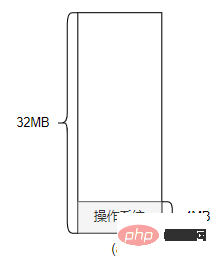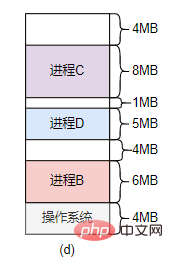 Operation and Maintenance
Operation and Maintenance
 Linux Operation and Maintenance
Linux Operation and Maintenance
 The system obviously has a lot of memory, but it cannot allocate a large piece of memory?
The system obviously has a lot of memory, but it cannot allocate a large piece of memory?
The system obviously has a lot of memory, but it cannot allocate a large piece of memory?
Today’s question: The system obviously has a lot of memory, but it cannot allocate a large piece of memory?
Why is this?
This question involves an aspect of memory management - memory fragmentation
What is memory fragmentation?
Memory fragmentation has appeared very early in Linux. Understanding the history of early memory fragmentation will help us understand it.
Assume that there is a piece of 32MB memory. At first, the operating system uses the smallest piece of memory - 4MB, and the remaining memory is reserved for 4 processes, as shown in Figure (a).

Process A uses 10MB of memory above the operating system, process B uses 6MB of memory above process A, and process C uses 8MB of memory above process B. , as shown in Figure (b),:

Process D requires 5MB of memory, so the remaining memory is not enough to load process D, and the last bit of this memory forms The first hole (memory fragment). Assume that at a certain moment, the operating system needs to run process D because there is not enough memory in the system, so it needs to select a process to swap out to make enough space for process D. Assume that the operating system selects process B to swap out, so that process D is loaded into the address space of the original process B, thus creating a second hole, as shown in Figure (c):

Assume that the operating system needs to run process B at a certain moment, and also needs to select a process to swap out. Assuming that process A is swapped out, then a third process will occur in the operating system holes , as shown in Figure (d):

As time goes by, there will be more and more memory holes, and the memory utilization will also increase. Decreasing, these memory holes are what we often call Memory fragmentation.

After seeing this, you already know what memory fragmentation is, and you also understand a memory management mechanism-dynamic partitioning method. The above example is actually dynamic partitioning method. In the early days of the operating system, dynamic partitioning method was used to manage memory.
How to solve the memory fragmentation problem?
The idea is actually very simple: Put multiple small blocks of memory into one large block of memory.
In early operating systems that used dynamic partitioning, in order to solve the problem of fragmentation, they dynamically moved the process so that the space occupied by the process was continuous, and all free space was also continuous, In this way, multiple small memory blocks are put together. But the shortcomings are also very obvious. Process migration takes a lot of time.
Inner fragmentation and outer fragmentation
There are two types of memory fragmentation: Inner fragmentation and External fragmentation
Inner fragmentation: The part of the memory allocated to the program but not used
External fragmentation: System Small memory blocks that cannot be used (such as the fragments generated by the above-mentioned dynamic partitioning method)
Nowadays, operating systems use paging or segmentation mechanisms to manage memory, but some memory fragments will inevitably be generated.
In order to solve the problem of internal fragmentation and external fragmentation, Linux introduced two things: Partner system and slab.
The partner system is used to solve the problem of external fragmentation, and the slab is used to solve the problem of internal fragmentation.
The partner system and slab are also core contents in memory management. If you are interested, you can study it.
Summary
So, when the system has a lot of memory but cannot allocate a large block of memory, that is Because a lot of memory fragmentation is generated, there are many discontinuous small pieces of memory in the system. On the surface, it seems that the system has a lot of free memory, but in fact it is just scattered memory.
The above is the detailed content of The system obviously has a lot of memory, but it cannot allocate a large piece of memory?. For more information, please follow other related articles on the PHP Chinese website!

Hot AI Tools

Undresser.AI Undress
AI-powered app for creating realistic nude photos

AI Clothes Remover
Online AI tool for removing clothes from photos.

Undress AI Tool
Undress images for free

Clothoff.io
AI clothes remover

AI Hentai Generator
Generate AI Hentai for free.

Hot Article

Hot Tools

Notepad++7.3.1
Easy-to-use and free code editor

SublimeText3 Chinese version
Chinese version, very easy to use

Zend Studio 13.0.1
Powerful PHP integrated development environment

Dreamweaver CS6
Visual web development tools

SublimeText3 Mac version
God-level code editing software (SublimeText3)

Hot Topics
 1386
1386
 52
52
 Difference between centos and ubuntu
Apr 14, 2025 pm 09:09 PM
Difference between centos and ubuntu
Apr 14, 2025 pm 09:09 PM
The key differences between CentOS and Ubuntu are: origin (CentOS originates from Red Hat, for enterprises; Ubuntu originates from Debian, for individuals), package management (CentOS uses yum, focusing on stability; Ubuntu uses apt, for high update frequency), support cycle (CentOS provides 10 years of support, Ubuntu provides 5 years of LTS support), community support (CentOS focuses on stability, Ubuntu provides a wide range of tutorials and documents), uses (CentOS is biased towards servers, Ubuntu is suitable for servers and desktops), other differences include installation simplicity (CentOS is thin)
 How to use docker desktop
Apr 15, 2025 am 11:45 AM
How to use docker desktop
Apr 15, 2025 am 11:45 AM
How to use Docker Desktop? Docker Desktop is a tool for running Docker containers on local machines. The steps to use include: 1. Install Docker Desktop; 2. Start Docker Desktop; 3. Create Docker image (using Dockerfile); 4. Build Docker image (using docker build); 5. Run Docker container (using docker run).
 How to install centos
Apr 14, 2025 pm 09:03 PM
How to install centos
Apr 14, 2025 pm 09:03 PM
CentOS installation steps: Download the ISO image and burn bootable media; boot and select the installation source; select the language and keyboard layout; configure the network; partition the hard disk; set the system clock; create the root user; select the software package; start the installation; restart and boot from the hard disk after the installation is completed.
 Centos options after stopping maintenance
Apr 14, 2025 pm 08:51 PM
Centos options after stopping maintenance
Apr 14, 2025 pm 08:51 PM
CentOS has been discontinued, alternatives include: 1. Rocky Linux (best compatibility); 2. AlmaLinux (compatible with CentOS); 3. Ubuntu Server (configuration required); 4. Red Hat Enterprise Linux (commercial version, paid license); 5. Oracle Linux (compatible with CentOS and RHEL). When migrating, considerations are: compatibility, availability, support, cost, and community support.
 What to do if the docker image fails
Apr 15, 2025 am 11:21 AM
What to do if the docker image fails
Apr 15, 2025 am 11:21 AM
Troubleshooting steps for failed Docker image build: Check Dockerfile syntax and dependency version. Check if the build context contains the required source code and dependencies. View the build log for error details. Use the --target option to build a hierarchical phase to identify failure points. Make sure to use the latest version of Docker engine. Build the image with --t [image-name]:debug mode to debug the problem. Check disk space and make sure it is sufficient. Disable SELinux to prevent interference with the build process. Ask community platforms for help, provide Dockerfiles and build log descriptions for more specific suggestions.
 How to view the docker process
Apr 15, 2025 am 11:48 AM
How to view the docker process
Apr 15, 2025 am 11:48 AM
Docker process viewing method: 1. Docker CLI command: docker ps; 2. Systemd CLI command: systemctl status docker; 3. Docker Compose CLI command: docker-compose ps; 4. Process Explorer (Windows); 5. /proc directory (Linux).
 Detailed explanation of docker principle
Apr 14, 2025 pm 11:57 PM
Detailed explanation of docker principle
Apr 14, 2025 pm 11:57 PM
Docker uses Linux kernel features to provide an efficient and isolated application running environment. Its working principle is as follows: 1. The mirror is used as a read-only template, which contains everything you need to run the application; 2. The Union File System (UnionFS) stacks multiple file systems, only storing the differences, saving space and speeding up; 3. The daemon manages the mirrors and containers, and the client uses them for interaction; 4. Namespaces and cgroups implement container isolation and resource limitations; 5. Multiple network modes support container interconnection. Only by understanding these core concepts can you better utilize Docker.
 What computer configuration is required for vscode
Apr 15, 2025 pm 09:48 PM
What computer configuration is required for vscode
Apr 15, 2025 pm 09:48 PM
VS Code system requirements: Operating system: Windows 10 and above, macOS 10.12 and above, Linux distribution processor: minimum 1.6 GHz, recommended 2.0 GHz and above memory: minimum 512 MB, recommended 4 GB and above storage space: minimum 250 MB, recommended 1 GB and above other requirements: stable network connection, Xorg/Wayland (Linux)




